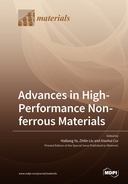Explore

Advances in High-Performance Non-ferrous Materials
0 Ungluers have
Faved this Work
Login to Fave
Nowadays, there is great pressure on energy conservation and emission reduction. In order to achieve these goals, weight reduction in manufacturing fields, such as the vehicle, marine, and aerospace industries, and microelectromechanical systems is the major trend. Although some structures and parts that require special properties and service conditions must use ferrous materials such as steels due to their superior thermal and wear resistance, there is a desperate need to replace these alloys with non-ferrous materials such as Al alloys, Mg alloys, Ti-based alloys, Cu alloys, and others in order to decrease the operational and maintenance costs. Recently, many new material processing techniques, i.e., irradiation, cryogenic rolling, wet chemical method, induction sintering, liquid/solid casting, heat treatment, electromagnetic hot forming, and five-axis flank milling, have been developed to enhance the performance of non-ferrous materials. Excellent work hardening, fracture toughness, mechanical properties, magnetic properties, and wear resistance could be realized depending on the appropriate application of these new technologies. This Special Issue covers these topics and focuses on the process–structure–properties relationships of high-performance non-ferrous materials.
This book is included in DOAB.
Why read this book? Have your say.
You must be logged in to comment.
Rights Information
Are you the author or publisher of this work? If so, you can claim it as yours by registering as an Unglue.it rights holder.Downloads
This work has been downloaded 67 times via unglue.it ebook links.
- 67 - pdf (CC BY) at Unglue.it.
Keywords
- 15%SiCp/2009 aluminum matrix composite
- 3D printing
- 7050 ingot
- 7050-T7651 plate
- 7075-T6 aluminum alloy
- aging behavior
- Al-3Ti-0.15C
- Al-5Ti-0.2B
- Al-Cu-Li alloy
- Al-Si-Cu alloy
- Al/steel bimetal
- Al2O3-reinforced
- aluminum alloy
- annealing
- annealing temperature
- bonding
- bonding strength
- cast Cu-Sn
- cast Cu-Sn-Ti
- CeO2 size
- CNC machining
- compound casting
- Creep
- cryogenic rolling
- cryogenic treatment
- cryorolling
- Cu-Ti-Cr-Mg alloy
- Cu/Al clad sheet
- DSC
- EBSD
- electromagnetic forming
- EMR
- Energy consumption
- EPMA
- EU
- five-axis flank milling
- fracture mechanism
- fracture toughness
- friction work
- Grain growth
- grain size
- hardness
- heat treatment
- Heusler alloys
- high-purity nickel
- History of engineering & technology
- homogenization
- hot forming
- in situ observation
- in situ vanadium carbide
- interfacial reaction
- interlayer
- intermetallic
- irradiation embrittlement
- lamellar-structure grains
- mathematic models
- Mechanical properties
- Mechanical Property
- Metals and Alloys
- microcrack
- microstructural evolution
- Microstructure
- mixed rare earth
- n/a
- neutron irradiation
- Ni-Co-Mn-In ribbons
- non-ferrous
- Numerical Simulation
- ODS-W
- oxidation
- percentage of cross-shear region
- phase transformation
- quasi in situ
- quenching experiment method
- refining performance
- slab method
- slip band
- spinodal bronze
- spiral bevel gears
- strip asymmetrical rolling
- Technology, engineering, agriculture
- Technology: general issues
- tensile property
- Texture
- thermodynamic calculation
- thermoelectric power
- Ti–5Al–5Mo–5V–1Cr–1Fe alloy
- tool path planning
- transformation
- transmutation Si
- tribological behavior
- tungsten alloy plates
- Twins
- two-phase zone continuous casting
- wear-resistant composite
- wet chemical method
Links
DOI: 10.3390/books978-3-0365-6653-5Editions

